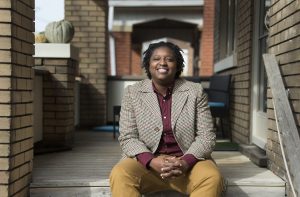Earlier this week, I tuned into a local radio station to hear a take on a story I've been following. By the end of that bit, I thought, wow, this reminded me of the radio I used to hear when I was growing up in South Florida. Then I thought, wait a minute – this is the same thing I heard 30 years ago. It hasn't changed. It’s similar voices on the same platform with the same conversations.
It made me think of the corporate diversity and inclusion call-to-arms to get more voices around the table.
But what if it’s the table that’s the problem?
Two local writers are working not only to bring diverse voices to new audiences, but they’re building a new media outlet to share these stories.
“It’s interesting to hear a lot of talk about having different voices at the table and hearing from diverse perspectives,” said Fitsum Areguy. “I think the real paradigm shift that has to happen is creating a different table. It’s not just inviting people into systems that are inequitable, or could cause harm, or aren’t telling stories that we need to be told. You need to create things outside of these pre-existing systems in order to tell certain stories.”
The answer for Areguy and co-founder Teneile Warren is insideWaterloo. Launching this February, the new independent media outlet will showcase the stories and voices of Black, Indigenous and racialized communities in Waterloo Region.

Teneile Warren (photo courtesy Grand Magazine)
Amplifying BIPOC voices and stories is nothing new for the experienced duo. Areguy is a community worker and advocate for youth rights and disability justice. He is also the co-founder and lead editor of Textile, a local arts organization that focuses on mentoring writers and artists to help bring their stories to new audiences. Warren is an established poet and playwright – in addition to being a chef and owner of Nyam Afro-Caribbean Kitchen and the Diversity and Inclusion Co-ordinator at the Kitchener Public Library.
Warren said the new outlet’s need is driven by a growing understanding of how existing systematic structures affect marginalized communities. “The reality that all of these entities, media sources we turn to for truth and fairness were developed within those systemic frameworks. It’s not incidental or accidental that they have failed at creating voice for marginalized communities. It is by design that they failed in creating voice for marginalized communities.”
Warren pointed to local news coverage of police as an example of embedded bias. “We all bring a lived perspective to how a story is told. It doesn’t matter that it’s just a who, where, what, when, how story,” said Warren. “When you look at how WPRS stories, for example, are published, we literally just run the press release – which goes against everything you’re taught in journalism school. That when you get a story, you need to fact check it, you need to get the other side. But that’s also a social bias of who we trust and who we don’t trust. So in order to create voice, you have really no choice but to create a new space.”
“Daily newspapers are a grind, you have to get stories out,” added Areguy who just completed an eight-month reporting stint at the Waterloo Region Record as part of the Local Journalism Initiative Reporter program. “It makes sense to me that police briefs get sent to newspapers and they get published as is because that’s what it is. That’s how it’s always been. People still look to dailies and radio programs for their day-to-day news; there’s a real need for that. But there’s also a need to tell diverse, complex, and marginalized stories in very intentional ways. And that has to happen outside of pre-existing systems.”
Areguy pointed to a current issue at the CBC brought on by the firing of journalist Ahmar Khan for a tweet about racist and xenophobic comments made by Don Cherry. More than 100 CBC journalists have signed a letter asking for the broadcaster’s head of journalistic standards, Paul Hambleton, to be replaced with a panel so that journalists of colour can do their jobs without fear of discrimination.

Fitsum Areguy (photo courtesy Textile Magazine)
“We’re realizing that in this sort of awakening, or deepening of understanding around racial injustice and structural inequities in our society, that journalism is not outside of that,” added Areguy.
Creating a new space with insideWaterloo addresses both the goal to amplify Black, Indigenous and racialized voices and present news stories through an equity and critical race lens. There will also be long-form pieces telling the stories of under-represented groups in our community and investigative reporting that delves into issues we normally only get a glimpse of.
“Take the school resource officer program,” said Warren. “We’ve kind of seen the media not really ask questions, really engage with the community, you know, talk to parents, look at this from a larger standpoint, look at the police-free movement overall. These types of stories that really kind of bring it together also educate the audience. It’s what we’re pushing for, it’s what we’re hoping to create.”
Areguy hopes that insideWaterloo stories will bring more attention to areas in our community that many residents don’t know exist. While writing for the Record, Areguy received an email from a reader in reaction to a piece about the impact of the second wave of COVID-19 on Black neighbourhoods in Waterloo Region.
“Someone emailed me very angrily saying, ‘We are not the States, we don’t have Black neighbourhoods here’,” Areguy said. “I responded saying, ‘You know, in fact, we have historic Black neighborhoods and populations here that just aren’t written about in our mainstream media or in our tellings of the Region’s history.’ It gets left out."
By telling these untold stories and amplifying unheard voices, Areguy and Warren aim to round out the news media ecosystem locally. “There are things that other outlets are going to do really, really well that that we’re not doing or aren’t going to do. And there are things that we’re gonna do that other outlets can’t do,” added Areguy.
Similar to other independent news outlets, insideWaterloo stories will be published online. They also plan to produce printed versions with top stories at various times during the year.
Understanding the needs of readers is front and centre for the team. They have issued an online survey to collect input on content and direction for insideWaterloo. “We want to know more about what people would want out of a publication,” Warren said. “So there is some back and forth, and we’re filling what we see as a gap. But we also want to know, what’s gonna land for people? Is it a podcast? Is it video? So we’re collecting that information and it’ll factor into how this rolls out.”
As with any startup – tech or media – accessing a support network is a key to getting off the ground. The insideWaterloo team is working with Indiegraf, a network of independent news entrepreneurs that supports new media sites with mentoring and revenue support.
When it comes to what success will look like, Warren said that for her, it is two things: first, seeing a shift in how under-represented communities see themselves in the stories and, second, seeing a change in how the majority white communities include under-represented communities in their stories of the Region.
“I came from Jamaica with one story of Canada,” Warren said. “Then in living here, I have learned so much. And so, you know, when people tell me what Canada is like, I can’t tell you what Canada is like. I can tell you about what eastern Toronto is like. And I can tell you about my experience so far. I think it’s just opening people’s minds, for me, will be success.”
For Areguy, it’s about showing both representation in the stories and representation for future writers, journalists and storytellers.
“When I started at the Record, so many people reached out to me, a lot of them youth. They couldn’t believe it, you know, there was somebody from their community who had a byline in the paper. That was huge for some people. And I got emails all the time from folks who were just thrilled that somebody who looked like them and had similar experiences growing up here reflected in who gets to tell the news. This new venture is a step in a different direction. It’s even more mind-blowing. We’re not just asking to be a part of the telling of news – we get to regain what we call narrative and visual sovereignty.”
# # #
While we’re staying home, I see and hear that....The Caribbean Canadian Association of Waterloo Region (CCAWR) is hosting Black History Month 2021. Celebrate, Advocate, and Educate is the theme of this year’s community Black History launch event this Saturday, Jan. 30 and Sunday, Jan. 31. The CCAWR is inviting Waterloo Region to join virtually on Facebook or YouTube for a two-day event filled with speakers, performances, discussions and more. On Monday, Feb. 1 at 7 p.m., the Kitchener-Waterloo Linux User Group features Christian Snyder discussing how he used open source software to set up a storytelling project for Reception House.

